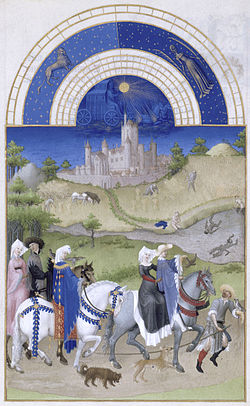Zelter (horse)


In the Middle Ages, Zelter referred to a light riding horse or mule that was able to walk in a tent that was particularly calm and comfortable for the rider (the special gaits pass and tölt as a one-sided step ). In terms of speed, the tölt is by no means inferior to the trot . The modern term is gaited horse .
It is often assumed that in the Middle Ages most of the mounts were tenters, as the tölt and pass walk was more comfortable for all riders on long journeys. However, especially traveling horses and horses for women and clergy were drawn and trained to this comfortable gait . From the late Middle Ages, side saddles on which the rider sat across the horse were common for noble women . This made sitting more lively and gaits such as trot and gallop impossible. However, tölt could even be sat in the transverse seat, as it has no suspension phase. It was also possible to have two parents carry a litter, while that would be impossible between two trotting horses. Elegant tents served as parade horses for princes and clergy. Tents were not used for fighting in battle; for this purpose, larger, heavier battle horses were used that only had to master three gaits.
The predisposition to the special gaits is inheritable in horses. Even today, some horses still show a more or less pronounced preference for it, which is only desirable in certain breeds. This includes the Icelandic horse and the Paso Peruano , a descendant of the Spanish Berber horses, which were often trained and used as tenters in the Middle Ages.
In the chivalric novels of the Middle Ages and early modern times, precious and decorated tenters are often described as ladies' horses. The refined description ( ekphrasis ) of the white and black tent of the Enite in Hartmann von Aues Erec novel (around 1180/90) is famous for literary history .
literature
- Andrea-Katharina Rostock and Walter Feldmann: Icelandic horse riding instruction . 2nd edition, with an appendix on Tölt and Pass by Mary-Ann Zyderfeld (pp. 285–337). Bad Honnef 1987.
- Rudolf Kilian Weigand: Schône sam ein schef enzelt ("Erec" v. 1439) or: How did Enite's horse walk? In: Robert Luff, Rudolf Kilian Weigand (ed.): "Mysticism - Tradition - Natural History". Eichstätter Symposium on April 16 and 17, 1999 . Olms-Weidmann, Hildesheim 2002 (= Germanist texts and studies. Vol. 70), pp. 77–108. ISBN 3-487-11805-X .